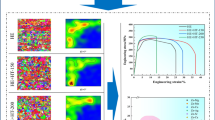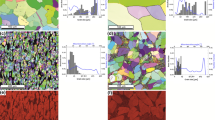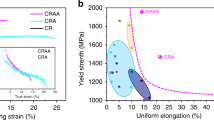Abstract
The nucleation, variant selection, and orientation dependence of the strain-induced martensitic transformation (SIMT) process in biomedical Co–Cr–W–Ni alloys were investigated. The experimental results show that the ε-hexagonal-close-packed phase was preferentially formed at the Σ3 twin boundaries and high-angle grain boundaries during the tensile process. The theoretical analysis shows that the variant selection of SIMT is governed by Schmid’s law. However, the SIMTed ε-phase did not form equally on the two sides of the annealing twins, even though they had the same Schmid factor. This phenomenon is related to the mechanical work developed by the formation of the ε-phase. Only the side which has both high Schmid factor and high mechanical work can initiate the SIMT process. A strong 〈111〉 fiber texture was formed, and the ε-variants tended to appear in grains with orientations close to the 〈111〉 and 〈100〉 directions during the tensile process. These results can provide theoretical guidance for controlling the SIMT process of Co–Cr–W–Ni alloys to fabricate more reliable stents.









Similar content being viewed by others
References
Wang Z, Xu XW, Zhang B. Hot compression deformation behavior of biomedical Ni–Ti alloy. Rare Met. 2019;38(7):609.
Ma XQ, Niu HZ, Yu ZT, Yu S, Wang C. Microstructural adjustments and mechanical properties of a cold-rolled biomedical near β–Ti alloy sheet. Rare Met. 2018;37(10):846.
Li BQ, Li CL, Wang ZX, Lu X. Preparation of Ti–Nb–Ta–Zr alloys for load-bearing biomedical applications. Rare Met. 2019;38(6):571.
Zhang EL, Fu S, Wang RX, Li HX, Liu Y, Ma ZQ, Liu GK, Zhu CS, Qin GW, Chen DF. Role of Cu element in biomedical metal alloy design. Rare Met. 2019;38(6):476.
Zhao DP, Tang JC, Nie HM, Zhang Y, Chen YK, Zhang X, Li HX, Yan M. Macro-micron-nano-featured surface topography of Ti–6Al–4V alloy for biomedical applications. Rare Met. 2018;37(12):1055.
Wang JL, Wan Y, Ma ZJ, Guo YC, Yang Z, Wang P, Li JP. Glass-forming ability and corrosion performance of Mn-doped Mg–Zn–Ca amorphous alloys for biomedical applications. Rare Met. 2018;37(7):579.
Huang L, Su K, Zheng YF, Yeung KWK, Liu MX. Construction of TiO2/silane nanofilm on AZ31 magnesium alloy for controlled degradability and enhanced biocompatibility. Rare Met. 2019;38(6):588.
Niinomi M, Nakai M, Hieda J. Development of new metallic alloys for biomedical applications. Acta Biomater. 2012;8(11):3888.
Marrey RV, Burgermeister R, Grishaber RB, Ritchie RO. Fatigue and life prediction for cobalt–chromium stents: a fracture mechanics analysis. Biomaterials. 2006;27(9):1988.
Byadretdinova MA, Ivanova RG, Lofis NA, Molotilov BV. Artificial heart valve made of Co–Cr–W–Ni alloy. Biomed Eng. 1986;20(1):21.
Zaman HA, Sharif S, Idris MH, Kamarudin A. Metallic biomaterials for medical implant applications: a review. Appl Mech Mater. 2015;735:19.
Narushima T, Mineta S, Kurihara Y, Ueda K. Precipitates in biomedical Co–Cr alloys. J Miner. 2013;65(4):489.
Zafarghandi MS, Abbasi SM, Momeni A. Effects of Nb on hot tensile deformation behavior of cast Haynes 25 Co–Cr–W–Ni alloy. J Alloys Compd. 2019;774:18.
Kumar VA, Gupta RK, Murty SVSN, Prasad AD. Hot workability and microstructure control in Co20Cr15W10Ni cobalt-based superalloy. J Alloys Compd. 2016;676:527.
Geetha M, Durgalakshmi D, Asokamani R. Biomedical implants: corrosion and its prevention—a review. Recent Pat Corros Sci. 2010;2:40.
Ueki K, Ueda K, Narushima T. Microstructure and mechanical properties of heat-treated Co–20Cr–15W–10Ni alloy for biomedical application. Metall Mater Trans A. 2016;47(6):2773.
Teague J, Cerreta E, Stout M. Tensile properties and microstructure of Haynes 25 alloy after aging at elevated temperatures for extended times. Metall Mater Trans A. 2004;35(9):2767.
Gupta RK, Karthikeyan MK, Bhalia DN, Ghosh BR, Sinha PP. Effect of microstructure on mechanical properties of refractory Co–Cr–W–Ni alloy. Met Sci Heat Treat. 2008;50(3–4):175.
Ueki K, Ueda K, Narushima T. Precipitate phases and mechanical properties of heat-treated ASTM F 90 Co–Cr–W–Ni alloy. Key Eng Mater. 2014;616:282.
Yamanaka K, Mori M, Kuramoto K, Chiba A. Development of new Co–Cr–W-based biomedical alloys: effects of microalloying and thermomechanical processing on microstructures and mechanical properties. Mater Des. 2014;55:987.
Kurosu S, Nomura N, Chiba A. Effect of sigma phase in Co–29Cr–6Mo alloy on corrosion behavior in saline solution. Mater Trans. 2006;47(8):1961.
Ueki K, Ueda K, Nakai M, Nakano T, Narushima T. Microstructural changes during plastic deformation and corrosion properties of biomedical Co–20Cr–15W–10Ni alloy heat-treated at 873 K. Metall Mater Trans A. 2018;49(6):2393.
Yamanaka K, Mori M, Chiba A. Enhanced mechanical properties of as-forged Co–Cr–Mo–N alloys with ultrafine-grained structures. Metall Mater Trans A. 2012;43(13):5243.
Hagihara K, Nakano T, Sasaki K. Anomalous strengthening behavior of Co–Cr–Mo alloy single crystals for biomedical applications. Scr Mater. 2016;123:149.
Mori M, Yamanaka K, Sato S, Tsubaki S, Satoh K, Imafuku M, Shobu T, Chiba A. Tuning strain-induced γ-to-ε martensitic transformation of biomedical Co–Cr–Mo alloys by introducing parent phase lattice defects. J Mech Behav Biomed Mater. 2019;90:523.
Yamanaka K, Mori M, Sato S, Chiba A. Stacking-fault strengthening of biomedical Co–Cr–Mo alloy via multipass thermomechanical processing. Sci Rep. 2017;7(1):10808.
Yamanaka K, Mori M, Koizumi Y, Chiba A. Local strain evolution due to athermal γ→ε martensitic transformation in biomedical CoCrMo alloys. J Mech Behav Biomed Mater. 2014;32:52.
Putaux JL, Chevalier JP. HREM study of self accommodated thermal ε-martensite in an Fe–Mn–Si–Cr–Ni shape memory alloy. Acta Mater. 1996;44(4):1701.
Rajan K. Phase transformations in a wrought Co–Cr–Mo–C alloy. Metall Trans A. 1982;13(7):1161.
Lee BS, Matsumoto H, Chiba A. Fractures in tensile deformation of biomedical Co–Cr–Mo–N alloys. Mater Lett. 2011;65(5):843.
Lee BS, Koizumi Y, Matsumoto H, Chiba A. Collective behavior of strain-induced martensitic transformation (SIMT) in biomedical Co–Cr–Mo–N alloy polycrystal: an ex situ electron backscattering diffraction study. Mater Sci Eng A. 2014;611:263.
Favre J, Koizumi Y, Chiba A, Fabregue D, Maire E. Deformation behavior and dynamic recrystallization of biomedical Co–Cr–W–Ni (L-605) alloy. Metall Mater Trans A. 2003;44(6):2819.
Koizumi Y, Suzuki S, Yamanaka K, Lee BS, Sato Y, Li YP, Kurosu S, Matsumoto H, Chiba A. Strain-induced martensitic transformation near twin boundaries in a biomedical Co–Cr–Mo alloy with negative stacking fault energy. Acta Mater. 2013;61(5):1648.
Wright SI, Larsen RJ. Extracting twins from orientation imaging microscopy scan data. J Microsc. 2002;205(3):245.
Humbert M, Petit B, Bolle B, Gey N. Analysis of the γ–ɛ–α′ variant selection induced by 10% plastic deformation in 304 stainless steel at − 60 °C. Mater Sci Eng, A. 2007;454:508.
Acknowledgements
This study was financially supported by the National Key R&D Program of China (No. 2017 YFA 0403804).
Author information
Authors and Affiliations
Corresponding author
Rights and permissions
About this article
Cite this article
Zhu, ZY., Meng, L. & Chen, L. Strain-induced martensitic transformation in biomedical Co–Cr–W–Ni alloys. Rare Met. 39, 241–249 (2020). https://doi.org/10.1007/s12598-019-01364-6
Received:
Revised:
Accepted:
Published:
Issue Date:
DOI: https://doi.org/10.1007/s12598-019-01364-6




